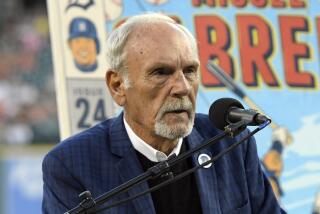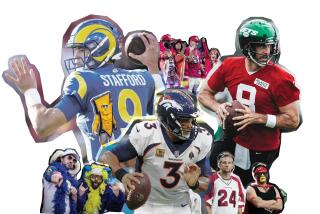How Will Templeton Do as He Gets Older? Oh, He’ll Manage
- Share via
You have probably had conversations like the one I had a few days ago. You know, rambling dialogues that start with trivial recollections and meander into theoretical projections.
In this particular conversation with a Midwestern colleague, we eventually set about to identify tomorrow’s baseball managers by assessing today’s team leaders.
“Who do you have on the San Diego club?” he asked.
“Garry Templeton,” I said.
“Garry Templeton,” he gasped. “You mean the guy they tarred and feathered in St. Louis?”
“Same guy,” I said. “Different person.”
Indeed, Garry Templeton, at 33, is to the Padres what Charlie Joiner was to the Chargers during the last few years of his career. He is The Professional, capital T and capital P.
While others have struggled around him, Templeton has been quietly putting together a solid year. I say quietly because Templeton does virtually nothing to call attention to himself, either statistically or aesthetically.
In terms of numbers, Templeton’s batting average has been steady around .250. However, the batting average is no barometer of his value. In fact, there is no way to statistically reflect what this man does for a baseball team.
So maybe you look to film clips and wonder why you don’t see him making sprawling bare-handed grabs or maybe doing back flips. Theatrics are not his forte, either.
Garry Templeton simply does the job.
You don’t see him making sprawling stops, because experience has taught him where to align himself, and instinct tells him where to go. Thus, Templeton casually scoops up ground balls other shortstops turn into adventures.
Templeton at shortstop is like maple syrup, smooth and sweet.
“I’ve been lucky,” teammate Tim Flannery said, “because I’ve played second base next to the best . . . Ozzie Smith and Tempy.”
Smith makes the highlight films, and Templeton makes the plays.
If you saw Templeton play shortstop against the Dodgers on Sunday, either on television or in person, you saw the position handled in a textbook manner. He went to the first base side of second to field one ground ball, veered to the right to tag a runner and threw to first for a double play, all the while keeping in mind that he had time because the hitter was a slow runner. He fielded another ball deep in the hole and threw quickly to third for a force, the only play he possibly had. He fielded another ball deep in the hole and ate it rather than risk a wild throw to first.
“A lot of young shortstops,” Flannery said, “would have thrown that ball just to see how close they could make it.”
But what it wouldn’t have made is sense.
Templeton knows those things, because he has come to know this game so well. And he also knows that this is the stage in his career when it is particularly important that he execute all those little things he has learned.
When it was suggested to him that he is having one of his best years since he came to the Padres in 1982, he thought for a moment and said: “In terms of numbers, no. If you’re talking about the way I’m playing, yes.”
That was what I was talking about. The way he is playing.
“When I first came up,” he said, “I thought it was just a matter of going out and playing hard like I did in Little League and high school and American Legion. I didn’t know there was as much strategy and knowledge involved in the game. You have to play to learn.”
And, as he has played, his role has changed, partially because a nagging knee injury won’t let him do what he did when he was younger.
“That’s something a lot of people don’t know about Tempy,” Flannery said. “I’ve seen guys come in here with needles and drain fluid from his knees, and he’s out playing an hour and a half later. Shortstop is tough enough to play without that. I played shortstop a few games when Tempy was hurt in ‘84, and it mentally wiped me out.”
In truth, Templeton’s value lies in the mental side of the game. Try measuring that .
“At this point in my career,” he said, “I have to be more mentally sound, especially on defense. I talked to older guys like Lou Brock when I came up, and they told me offense would start to slide as you get older. They told me to keep after my defensive skills.”
Essentially, Templeton is the stabilizer in the infield.
“He does a hell of a job directing the infield,” Manager Jack McKeon said. “I feel very good when he’s out there. And I know he’s going to make the plays.”
Oh yes, and Templeton has his own unique way of keeping the infielders alert. He throws dirt clods at them. Just watch. Let second baseman Robbie Alomar’s gaze drift off into the stands, and Templeton will let fly.
Ah, the man is an innovator. Clearly, managerial material.
“I’d love to manage someday,” he said, “but I’d want to spend some time working with the kids down below. If I did a decent job, I’d like to try my hand up here.”
Mark it down, my friend. Garry Templeton will manage in the major leagues.
First, however, there is some playing still to be done . . . physically and mentally.
More to Read
Go beyond the scoreboard
Get the latest on L.A.'s teams in the daily Sports Report newsletter.
You may occasionally receive promotional content from the Los Angeles Times.










